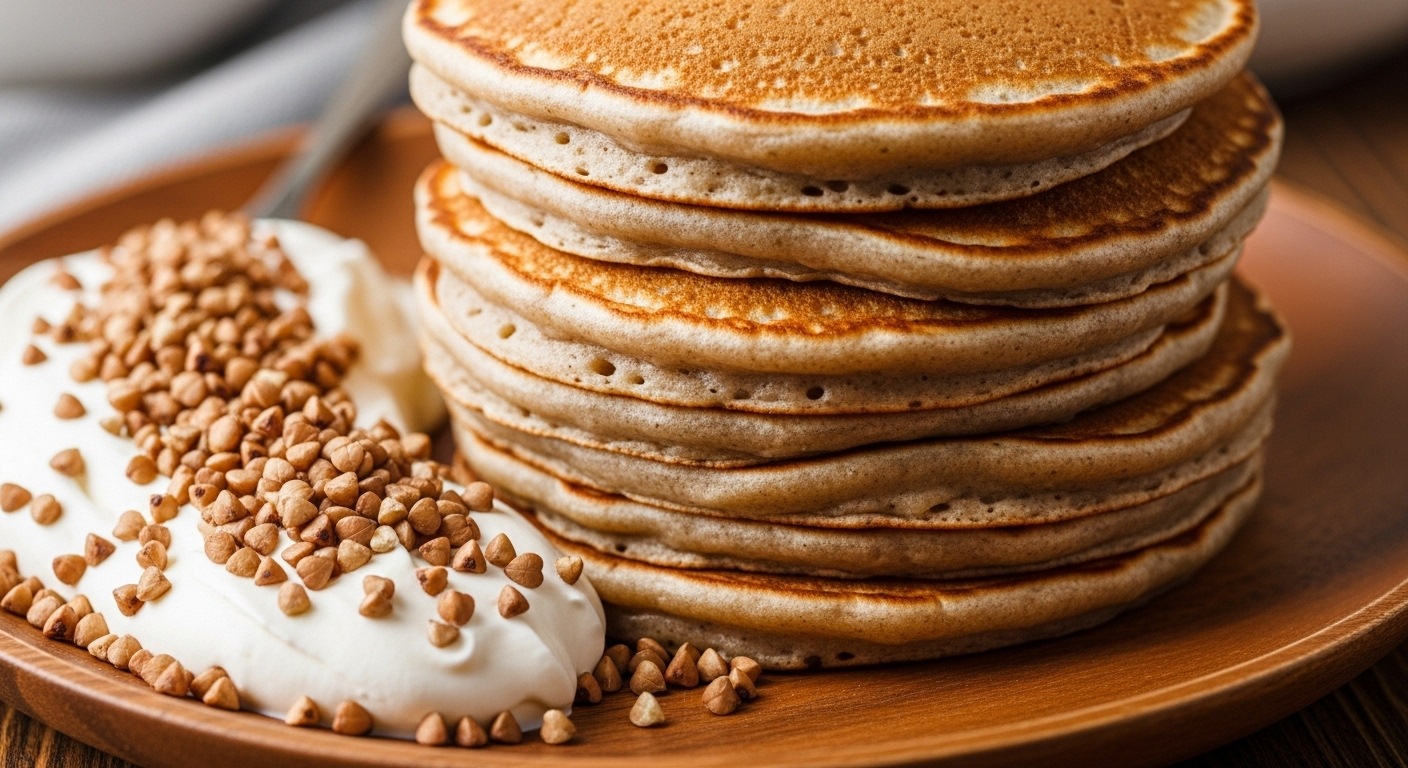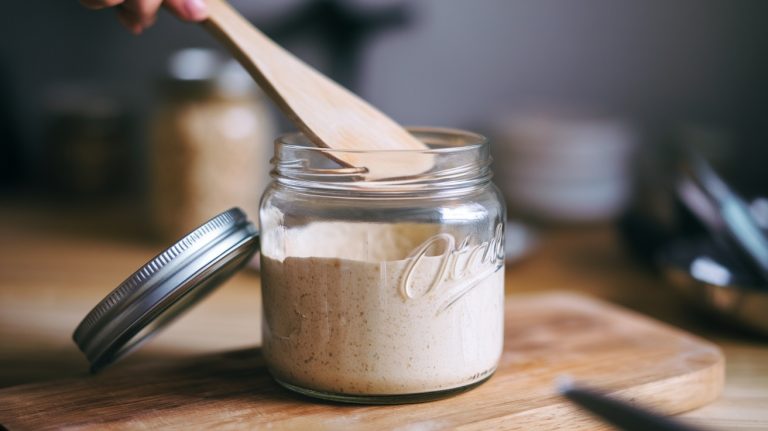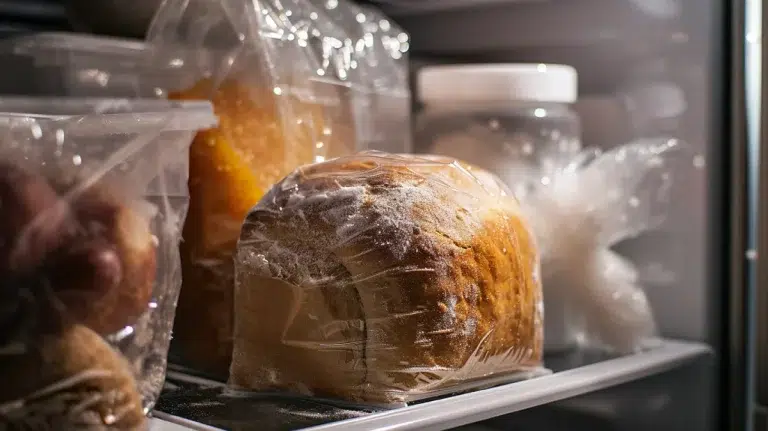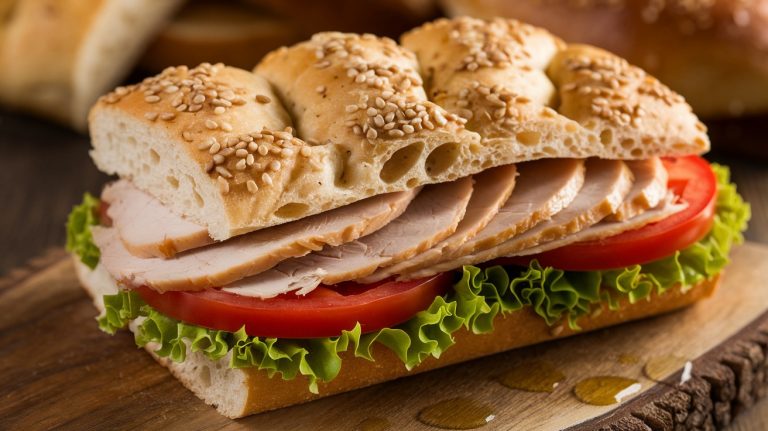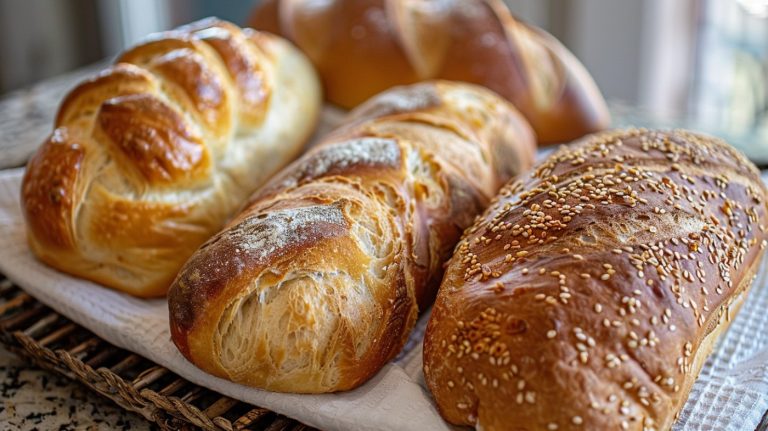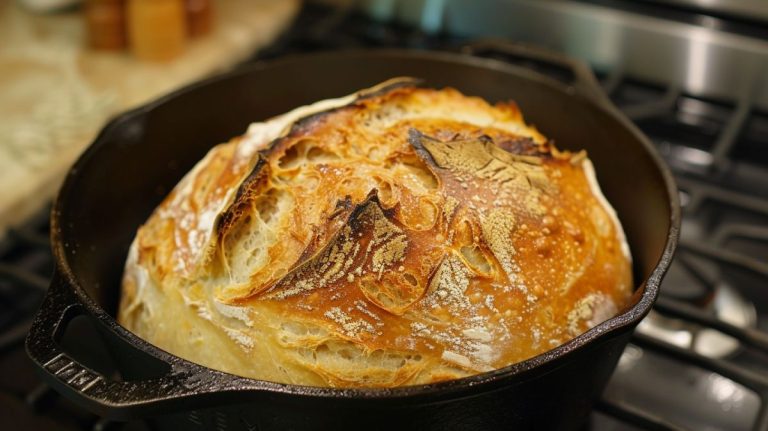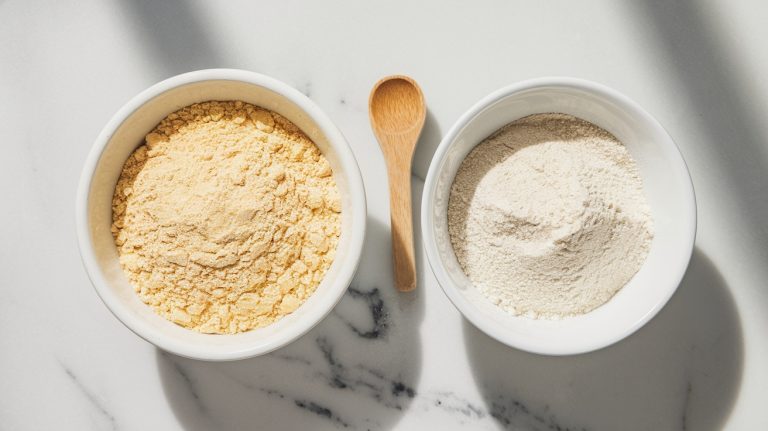Fermented Buckwheat Pancakes: Energy-Boosting Breakfasts
Discover the rustic appeal of fermented buckwheat pancakes, where each fluffy bite delivers a rich, earthy flavor that’s both satisfying and wholesome. These nutrient-packed pancakes offer impressive health benefits—loaded with fiber, protein, and powerful antioxidants like rutin that promote healthy digestion and combat inflammation.
The preparation is surprisingly simple: combine buckwheat flour with your sourdough starter and let the fermentation work its magic, enhancing nutrient absorption while developing that distinctive tangy depth.
Ready to elevate your breakfast game? Keep reading for creative topping ideas and flavor variations that’ll transform your morning routine.
Key Takeaways
- Fermented buckwheat pancakes use buckwheat flour as the main grain, offering high protein and fiber.
- Fermentation with sourdough or yeast enhances digestibility and nutrient absorption over 8-24 hours.
- Mix batter with buttermilk, eggs, and honey for a thick, pourable consistency before cooking.
- Cook on a preheated pan at 350°F–375°F using butter or oil for even browning.
- Serve with maple syrup, yogurt, or fruit compotes for a wholesome, delicious breakfast.
Benefits of Fermented Buckwheat
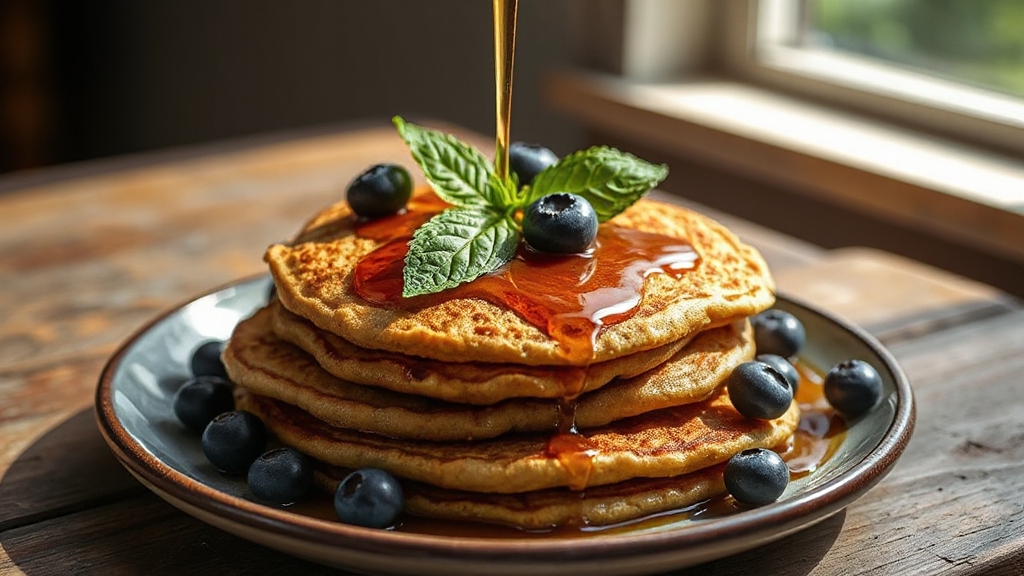
As you explore the world of fermented buckwheat, you’ll quickly discover it’s a nutritional powerhouse packed with benefits for your body. This gluten-free gem brims with fiber, supporting your digestive health, while its plant-based protein fuels your energy.
Rich in minerals like copper and manganese, it nourishes you from within. Additionally, its high antioxidant content, including rutin and quercetin, helps protect your cells from damage and supports overall wellness.
Beyond that, fermented buckwheat acts as a prebiotic, boosting beneficial gut bacteria and maintaining a balanced microbiome. Its antioxidants shield you from oxidative stress, potentially reducing inflammation and heart disease risk. Incorporating fermented buckwheat into recipes can also benefit from precision measurement tools to ensure consistent results in your baking endeavors.
You’ll also appreciate how it helps manage blood sugar and cholesterol levels, promoting cardiovascular wellness.
Essential Ingredients for the Recipe
Before you plunge into making fermented buckwheat pancakes, let’s gather the core ingredients that’ll bring this nutritious dish to life. You’ll need buckwheat (200-250g) as the hearty base, eggs for richness, and buttermilk for a tangy moistness. Add a touch of vanilla for subtle aroma, and don’t forget sweeteners like honey or maple syrup to elevate the flavor.
Additionally, using sprouted buckwheat can significantly boost nutrient density due to the increased vitamin B content during the sprouting process. For an added twist, consider incorporating a sourdough starter to enhance fermentation, much like the process used in sourdough bread mixes for improved texture and flavor.
Check out this quick guide to essential ingredients:
| Ingredient | Purpose | Amount |
|---|---|---|
| Buckwheat | Main grain base | 200-250g |
| Eggs | Adds protein, richness | 1-2 per batch |
| Buttermilk | Moisture, tangy flavor | 1-2 cups |
| Vanilla | Subtle aroma | 1 tsp |
| Honey/Maple Syrup | Sweetens naturally | 1-2 tbsp |
Choosing the Right Fermentation Starter
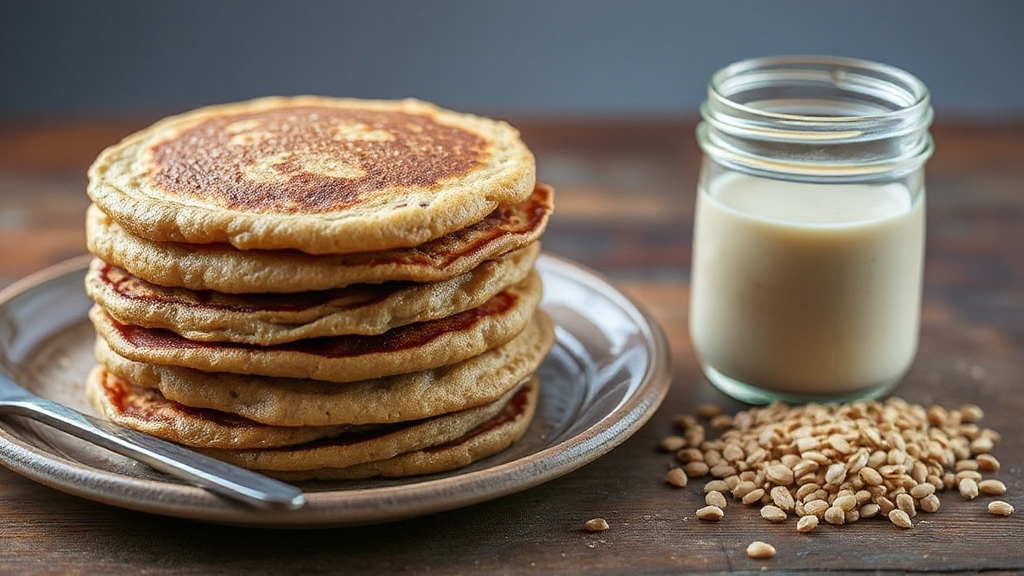
When picking a fermentation starter for your buckwheat pancakes, you’ve got exciting options like sourdough, yeast, or even live cultures such as kefir to shape the taste and texture.
Each starter brings a unique twist—sourdough offers a tangy depth, while yeast speeds things up with a milder, bread-like flavor.
Keep in mind that fermentation time varies too; sourdough needs 8–12 hours for that rich profile, but yeast can get you ready in under an hour. If you opt for sourdough, remember that a well-maintained starter with all-purpose flour can provide consistent fermentation results for your pancakes.
Additionally, using a buckwheat sourdough starter can enhance the health benefits of your pancakes, as it promotes better digestibility and nutrient absorption.
Starter Culture Options
Diving into the world of fermented buckwheat pancakes, you’ll find that selecting the right starter culture is key to crafting a batch that’s bursting with flavor and nutrition. Whether you’re craving a tangy kick or a mild creaminess, your choice of starter shapes the outcome.
Consider your taste preferences, dietary needs, and ease of maintenance when picking from vibrant options. For a gluten-free option, try a buckwheat sourdough starter organic buckwheat flour to ensure both unique flavor and dietary compatibility. Additionally, using a quality starter can be enhanced by tools like sourdough proofing baskets to inspire your overall baking journey.
Explore these enticing starter cultures to elevate your pancakes:
- Sourdough Starter: Delivers a classic sour punch and boosts digestibility.
- Milk Kefir: Infuses probiotics with a gentler flavor profile.
- Ginger Bug: Adds a zesty, fizzy twist for adventurous palates.
- Yogurt Culture: Brings creamy richness and extra health benefits.
Fermentation Time Impact
As you begin on perfecting your fermented buckwheat pancakes, remember that the fermentation time plays a pivotal role in shaping their flavor and texture. Opt for a short 30-minute warm fermentation at room temperature for a milder taste, then shift to cold fermentation in the fridge to slow things down.
If you’re craving a tangier bite, extend the process over hours or even days, boosting nutrient availability by breaking down phytic acid. This extended fermentation also enhances digestibility by introducing beneficial microbes that aid in nutrient absorption.
Monitor your batter closely to avoid over-fermentation, which can sour the flavor unpleasantly. Adjust based on your desired softness and bounce—longer times yield lighter, more digestible pancakes. For optimal results, consider using a sourdough starter to naturally enhance fermentation, similar to techniques used in bread baking.
Step-by-Step Batter Preparation
Before you whip up a batch of fermented buckwheat pancakes, let’s get started with the essential step of batter preparation. Grab your ingredients—200-250g buckwheat flour, 400g buttermilk or 125g water, and 4g yeast or 20g starter.
Ready to make fermented buckwheat pancakes? Start with the key step—batter prep. Gather 200-250g buckwheat flour, 400g buttermilk or 125g water, and yeast or starter.
Pour the liquid into a large bowl, dissolve yeast if using, and mix in 50g honey and 80g melted butter. Gradually whisk in the flour and a pinch of salt (2g) until smooth. For enhanced taste, consider a fermentation period (cold fermentation option) of 12 hours in the fridge. To elevate the flavor profile, experiment with adding fresh herbs like rosemary or thyme for a savory twist inspired by focaccia toppings.
Aim for a thick, pourable consistency, adjusting with liquid if needed.
Here’s how to make it fun and easy:
- Experiment with flavors: Add 10g vanilla or cinnamon for a cozy twist.
- Get hands-on: Whisk vigorously to feel the batter come alive.
- Eye the texture: Watch for a smooth, lump-free mix.
- Prep your space: Clear a spot for stress-free cooking.
Mastering the Fermentation Process
While preparing your buckwheat pancake batter is essential, mastering the fermentation process is where the magic truly happens. Set up a warm, draft-free spot—ideally between 75°F and 85°F—to let your batter ferment for 12 to 24 hours. Using tools like a thermometer can help ensure optimal baking conditions for consistent fermentation results.
Use a sourdough starter, kefir, or yogurt to kickstart the process, and keep the mixture covered and undisturbed. Watch for frothy bubbles and subtle gases; they’re signs it’s working!
Fermentation boosts buckwheat’s nutrients, enhances flavor, and supports gut health by reducing phytates. If you notice a sour smell or separation, don’t worry—stir it gently. Remember to use a dark vessel for fermentation to protect the mixture from light and enhance the process.
Maintain a steady temperature to avoid over-fermentation, and revel in creating a batter that’s as nutritious as it’s delicious.
Tips for Cooking Perfect Pancakes
Let’s get those fermented buckwheat pancakes just right by starting with your pan—preheat it over medium heat for a good 10-15 minutes to guarantee even cooking and prevent sticking.
Make sure you’re using a well-seasoned cast iron or non-stick surface, and don’t skimp on a touch of oil or butter before each batch for that perfect golden crust.
When it comes to batter, mix wet and dry ingredients just until combined to keep it light and fluffy, avoiding a dense texture that ruins the vibe.
Remember, proper soaking of buckwheat overnight helps neutralize phytic acid, enhancing digestibility and nutrient availability for a healthier meal.
Optimal Pan Heating
As you plunge into making fermented buckwheat pancakes, getting the pan heat just right is your ticket to golden, fluffy perfection. Aim for a medium heat setting, around 350°F to 375°F, to ensure a tender, fully cooked interior without burnt bottoms. Preheat your pan or griddle for 2 to 15 minutes, testing readiness with a sprinkle of water—if it sizzles, you’re set.
Remember, proper temperature control helps activate the leavening agents for that ideal rise proper temperature control. For best results, use a baking thermometer to ensure accurate temperature readings during the preheating process.
Here’s how to nail the heat:
- Use a nonstick or heavy-bottomed pan for even heat distribution.
- Maintain consistent medium heat, adjusting slightly if browning happens too fast.
- Opt for cast iron or anodized aluminum for stable temperatures.
- Check surface heat with an infrared thermometer for precision.
Batter Consistency Tips
Now that you’ve got the pan heat dialed in, let’s focus on crafting the perfect batter for your fermented buckwheat pancakes. Aim for a slightly thick, pourable consistency by adjusting the liquid content with buttermilk or nut milk. If it’s too thin, add a bit more buckwheat flour; if too thick, trickle in extra liquid.
Keep an eye on fermentation time—longer periods yield a thicker, tangier batter, while shorter ones keep it lighter. After mixing, let it rest a few minutes to settle. Handle it gently to preserve that frothy texture, essential for fluffy pancakes. Don’t over-stir, as it’ll deflate the batter. Remember, the batter will double in volume during fermentation, so use a large bowl to accommodate the expansion.
Additionally, consider how fermentation impacts the batter’s nutritional profile with resistant starch formation, which can lower glycemic responses and benefit overall health.
Flavor Enhancements and Toppings
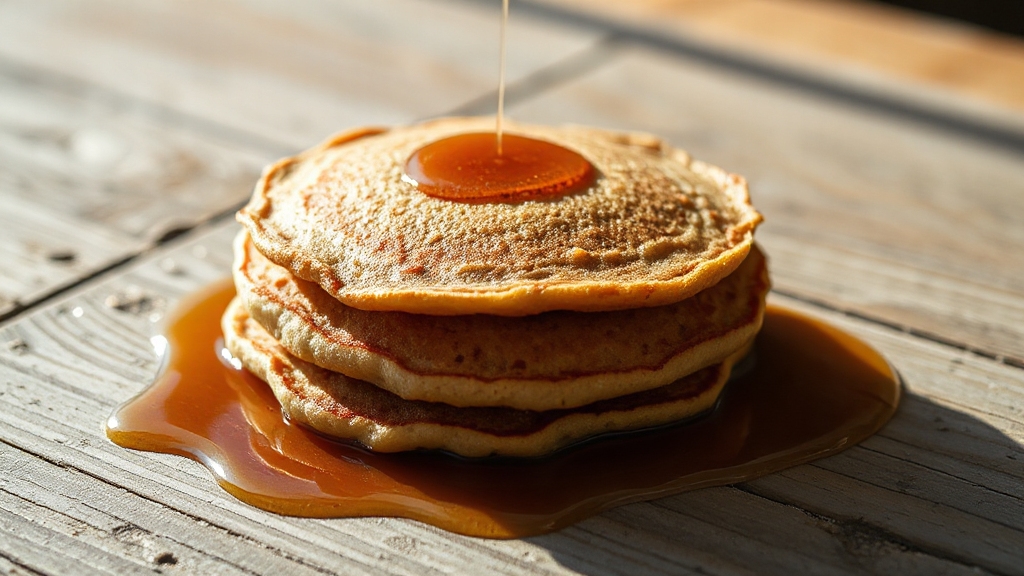
While fermented buckwheat pancakes already boast a unique, nutty flavor, you can elevate them further with an array of delightful toppings and enhancements. Imagine drizzling warm maple syrup over a stack, its sweetness amplifying the earthy notes, or dolloping tangy Greek yogurt for a creamy contrast.
For an even deeper flavor, consider adding a fragrant blueberry rose sauce to complement the pancakes’ yeasty, risen texture (blueberry rose sauce). Experimenting with fermentation times can also enhance the tanginess, much like the process used in Herman sourdough starters (Herman sourdough starters).
If you’re craving savory, mix herbs like dill into the batter or sprinkle grated cheese on top for a melty twist.
Try these irresistible ideas to enhance your pancakes:
- Sweet Bliss: Drizzle honey or top with a vibrant blueberry compote for a burst of flavor.
- Crunchy Texture: Add toasted walnuts or sesame seeds for a satisfying bite.
- Creamy Touch: Spoon on coconut yogurt for a tropical tang.
- Spiced Warmth: Dust with cinnamon for a cozy, aromatic finish.
Creative Variations to Try
If you’re enthusiastic to experiment with fermented buckwheat pancakes, plunge into a world of creative variations that’ll transform your breakfast game. Try different fermentation agents like sourdough starter or coconut yogurt, soaking the batter overnight for a tangy kick.
Switch between sprouted and non-sprouted buckwheat to play with texture—sprouted offers a lighter bite, while non-sprouted brings earthy depth.
Tailor your recipe with dietary tweaks: go dairy-free with almond milk or vegan with mashed banana as a binder. Adjust batter thickness for fluffy or thin pancakes, and cook on a sizzling cast iron for crispy edges. For an authentic touch, incorporate buckwheat flour’s unique earthy, bitter flavor to enhance the rustic profile of your pancakes.
Add a drizzle of maple syrup for sweetness, or mix in baking powder for extra rise. Get creative and make each batch uniquely yours.
Nutritional Insights and Health Impacts
Beyond the exciting domain of tweaking fermented buckwheat pancake recipes, let’s explore the impressive nutritional benefits and health impacts these pancakes bring to your table. You’re not just savoring a tasty meal; you’re fueling your body with gluten-free buckwheat, rich in protein, fiber, and complex carbs that stabilize blood sugar.
Fermentation boosts mineral absorption and nurtures gut health with prebiotic fibers, while sprouting enhances B vitamins for energy and stress relief. Additionally, buckwheat serves as a significant source of essential nutrients, offering 24% Daily Value of protein per serving to support your dietary needs.
Dive into these perks with enthusiasm:
- Protein Power: Get 13.3 grams per 100 grams, supporting muscle repair.
- Digestive Boost: High fiber aids digestion and satiety.
- Blood Sugar Balance: Low glycemic index prevents spikes.
- Antioxidant Shield: Combat inflammation with buckwheat’s natural compounds.
Frequently Asked Questions
Can Fermented Buckwheat Batter Be Frozen?
You can absolutely freeze fermented batter, locking in its tangy essence and health benefits.
Don’t worry about losing its magic—freezing won’t diminish its probiotic power. Use airtight containers to guard against freezer burn, and label them with dates.
You’ve got up to three months to enjoy this gem, so store it wisely and savor every bite!
How Long Does Cooked Batter Last?
Well, if you store it right, you’re looking at about a week of freshness in the fridge.
Pop it into an airtight container to keep it tasty. Don’t let it sit out too long before cooling it down, and always check for any odd smells or mold before digging in.
Is Buckwheat Safe for Nut Allergies?
Buckwheat is a pseudocereal with little direct cross-reactivity. Yet, don’t assume safety; some with nut allergies react due to separate sensitizations or contamination.
You’ve gotta get tested clinically before trying it. Stay cautious, read labels, and protect yourself from unexpected allergic surprises with informed choices.
Can I Use Buckwheat Groats Instead?
Absolutely, you can! Grab those hulled seeds and grind ‘em into a fine flour yourself for a nutty, nutritious twist in your recipes. It’s a fantastic swap, packed with protein and fiber.
Just make sure they’re processed properly since raw groats won’t work directly in batter. Get creative, toast ‘em first for extra flavor, and enjoy the wholesome goodness!
Does Fermentation Affect Buckwheat’s Color?
When you ferment it, the surface might shift to purple, pink, orange, or even brown due to oxidation or reactions with air.
Don’t worry, though—it’s totally normal and safe. The color change isn’t consistent every time, as it depends on factors like temperature or variety. Just mix it, and watch the hues blend away.
Flavorful Fuel: Creating Perfect Fermented Buckwheat Pancakes
Now you know-how to whip up fermented buckwheat pancakes that’re both tasty and nutritious. Imagine Sarah, a busy mom from Seattle, who switched to these pancakes and noticed her family’s energy levels soar thanks to the gut-friendly fermentation.
Plunge into, experiment with toppings, and savor the health benefits. Your kitchen’s about to become a hub of flavorful, wholesome mornings—get flipping and enjoy every bite.

